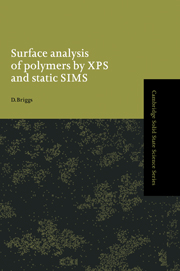Chapter 2 - XPS
Published online by Cambridge University Press: 08 October 2009
Summary
Instrumentation
XPS involves the irradiation of a sample with soft X-rays and the energy analysis of photoemitted electrons which are generated close to the sample surface. An X-ray photoelectron spectrometer (or XPS instrument) therefore consists of: a vacuum vessel with its associated pumping system and sample introduction/manipulation systems; an X-ray source; an electron energy analyser and its associated input (or transfer) electron–optical lens; an electron detection system and a dedicated ‘datasystem’ based on a PC or workstation which both controls the spectrometer operation and provides the means to process the acquired data. These components are now considered in turn.
Vacuum system
A comprehensive electron spectrometer vacuum system of typical early 1980s design is illustrated in Fig. 2.1. The spherical analysis chamber allows several probes and analysers to be mounted so that several surface spectroscopies can be applied to the same sample. The construction is mostly of stainless steel with joints made by compressing knife-edge flanges against copper gaskets. In XPS it is important to screen electron trajectories from the earth's magnetic field and this is achieved either by fabricating the analyser chamber and electron analyser/lens vessels out of a material with a high magnetic permeability, usually mu-metal, or by cladding the steel vessel with mu-steel sheeting (internally or externally).
In order for electrons to reach the analyser without being scattered by residual gas molecules, the achievable vacuum only needs to be about 10-5 Torr (1.33 X 10-3Pa), i.e. in the high vacuum regime. However, most vacuum systems routinely operative in the UHV regime (<10-9Torr) in order to reduce the contamination of sample surfaces by absorbed residual gas molecules.
- Type
- Chapter
- Information
- Surface Analysis of Polymers by XPS and Static SIMS , pp. 14 - 46Publisher: Cambridge University PressPrint publication year: 1998
- 2
- Cited by



